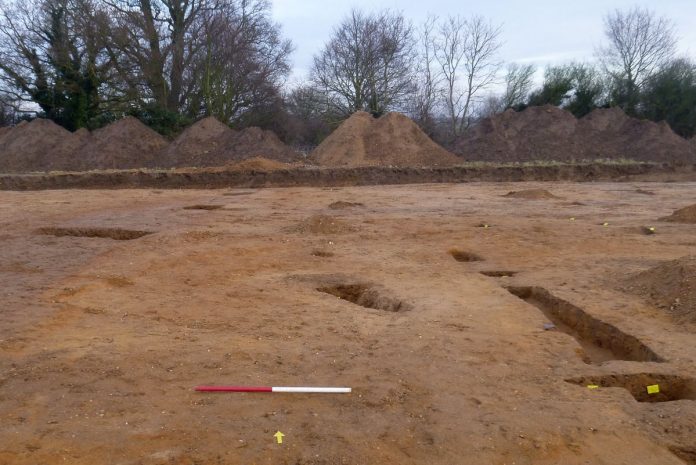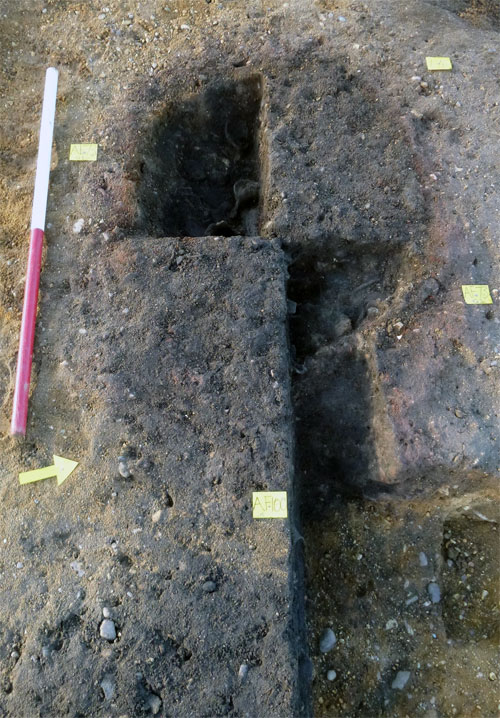On the 22nd January, among the linear features – thought to be field boundaries – the archaeologists were excited when fieldstaff uncovered the remains of a small Roman pottery kiln.
The superstructure of the kiln has been destroyed by ploughing, but he surviving substructure was contains the lower chamber of the kiln, where fuel was burned to produce the heat which fired the pottery vessels in the [now missing] upper chamber. This kiln was basic, and the consists of a keyhole-shaped feature: the narrrow part of the feature represents the flue, while the wider area represents the lower chamber.
Trust archaeologists have found kilns of various types and dates over the years but strangely this is only the fourth Roman pottery kiln which they have excavated – the others were at Colchester – one at Middleborough and two at Oaks Drive in Lexden, both in the 1970s.
In total, nearly 40 Roman pottery kilns have been recorded at Colchester since 1819. The kilns have been recorded at sites off Lexden Road, off Butt Road, at Mile End and at Sheepen, with evidence of two kilns at Fitzwalter Road. Sheepen produced a group of kilns with a kiln enclosure, which were excavated in the 1930s by the Colchester Excavation Committee (the precursor of the Trust). This group of kilns represented the industrial production of Roman pottery. Colchester was a large pottery-production centre in Roman Britain and the potters and workshops here supplied the town and also exported pottery to other places in Britain. (The remains of two Roman pottery shops have been observed on sites in Colchester High Street.)
Pottery was manufactured in the kilns around Roman Colchester for centuries, and it ranged from the most cheap and basic to very high-quality pottery, and in a wide range of forms. We even know the names of some of the workshops or potters who worked in Colchester, from the name stamps which they used on their pottery and which we have found: Acceptus iii, Cunopectus, Gabrus ii, T. Littera, Litugenus iv, and Senilis iv. Pottery was also imported into Colchester, from other production centres in Britain and on the Continent.
Roman life included the manufacture, trading, using and re-using of a lot of pottery, and so we excavate large amounts of Roman pottery fragments in Colchester. In Roman Britain, pottery was used for the storage and transportation of food and drink, food-processing, cooking, serving and eating; other domestic items such as lamps and candlesticks; cremation burial urns. Pots were wheel-thrown from clay and then fired in batches in specially-constructed kilns. There were different kinds of Roman pottery kilns, but here they were all built outside the Roman walled town.
Smaller Roman settlements, or perhaps even large farmsteads, also included pottery kilns, and examples have been recorded in the area around Colchester, eg at Ardleigh and Witham, and now we have uncovered the kiln near Manningtree. The kiln is very interesting in itself and it also provides further evidence of Roman activity and settlement near Manningtree.
The site is being supervised by Trust archaeologist Nigel Rayner.
Learn all about Roman Ceramics here at POTSHERD. This is a collection of pages on pottery and ceramics in archaeology, principally of the Roman period (1st cent. BC – 5th cent. AD) in Britain and western Europe. http://potsherd.net/atlas/potsherd.html

Source: Colchester Archaeological Trust


